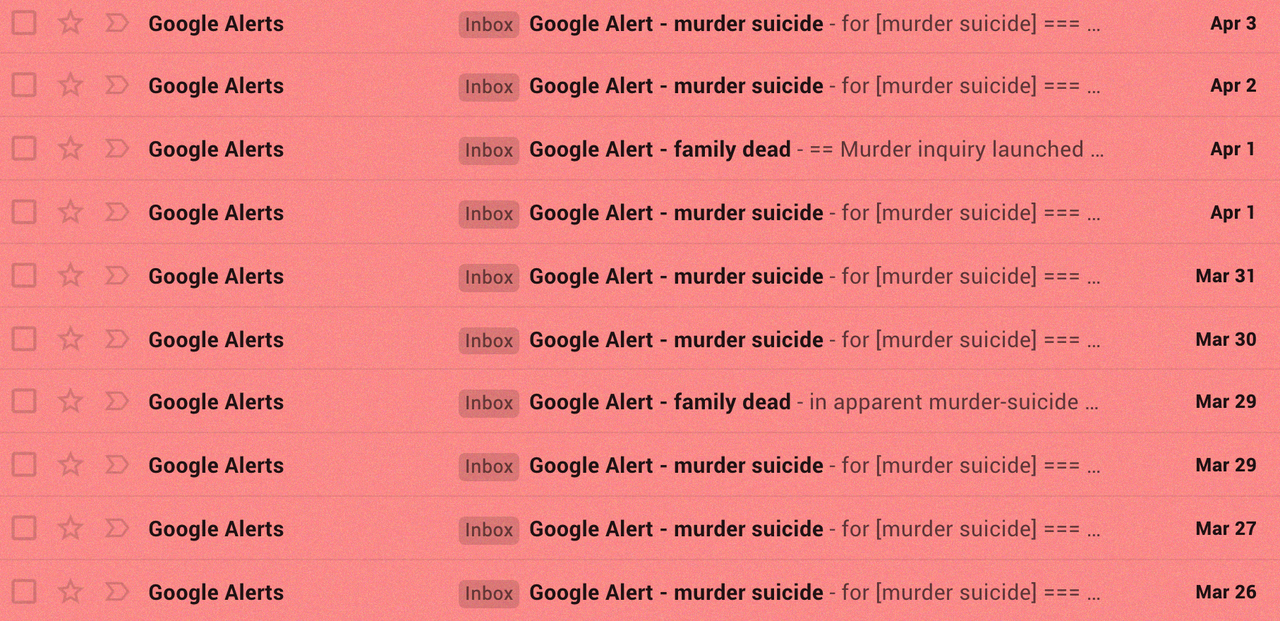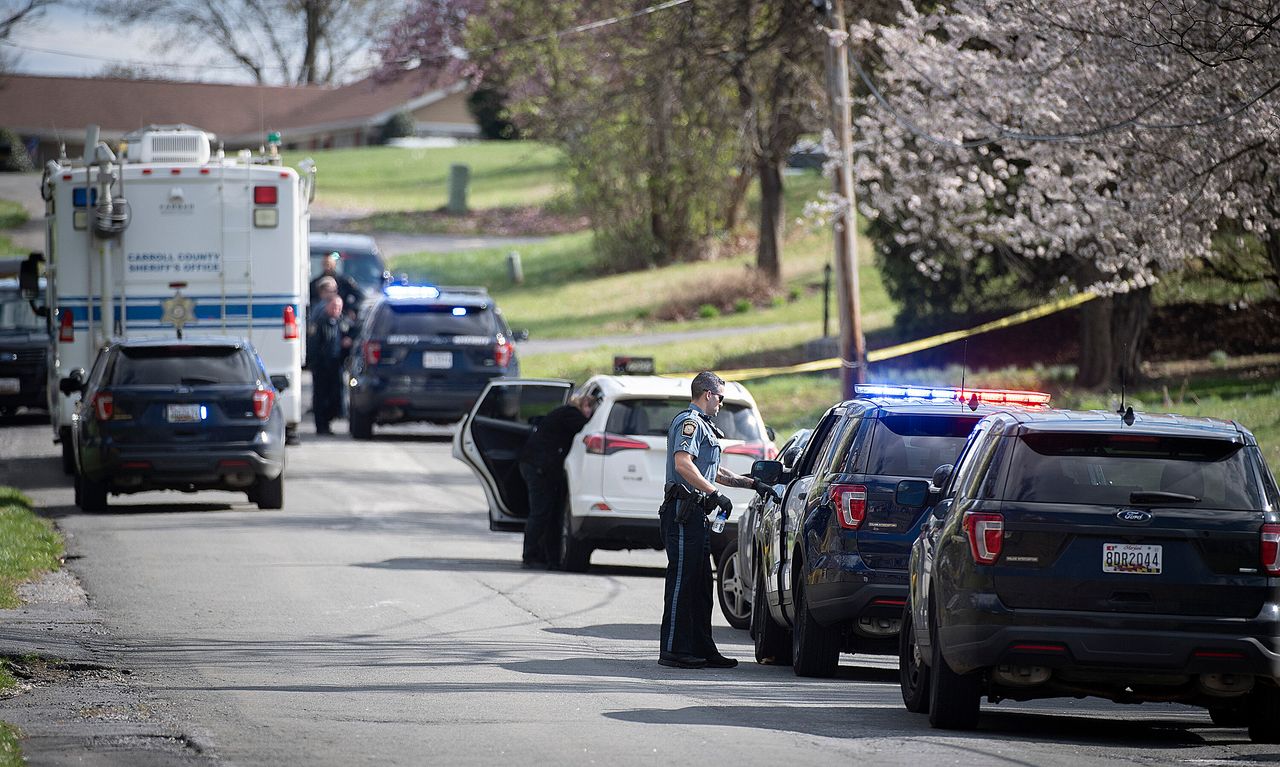On April 2, Joseph Zujkowski ignored Maryland’s stay-at-home order, put his rifle in his car and drove 30 minutes to his estranged wife’s house. When Heather Zujkowski, a 36-year-old Army veteran arrived home, he opened fire on her in the street, killing her and a teenage neighbor who was practicing lacrosse in his front yard. Then Zujkowski drove home and shot himself too.
The same day, in Georgetown, Texas, Ruben Tobias retrieved a handgun from his room and began firing on his girlfriend and her 15-year-old daughter. Then, he turned the weapon on himself. His girlfriend escaped with injuries, but her daughter, described as a “fun loving free spirited child,” did not.
Simultaneously, in Lockport Township, Illinois, officers responded to calls for a wellness check for a married couple. They found Cheryl Schriefer, 59, shot in the back of the head at close range. Her husband was dead of a self-inflicted gunshot wound. Family told police that he had been afraid that the couple had contracted the coronavirus. Neither had it, according to their autopsies.
As the U.S. tracks the mounting death toll of the coronavirus pandemic, which reached 20,000 on Saturday, there is another list of casualties that is steadily rising, mostly hidden from view: Victims of domestic violence.
For weeks, experts have warned that domestic violence would increase during the outbreak, as victims are forced to shelter with abusers and crucial support services ― such as courts, shelters and even other family members who serve as a type of protective shield from violence ― are out of reach.
Now, there are some preliminary warning signs that lethal domestic abuse is already on the rise.
In an average week in the U.S., around 11 murder-suicides occur. The vast majority of murder-suicides — when a person kills someone else (or multiple people) and then themselves — occur within intimate partners or families. The perpetrator, usually a man with a gun, targets his spouse or girlfriend or other family member before taking his own life.
Between March 27 to April 2, as the majority of states ordered the public to stay home, there were at least 19 murder-suicides (including four attempted ones), according to a HuffPost analysis. Almost all of the incidents involved a man killing his wife or child before taking his own life.
HuffPost identified murder-suicides using Google alerts and gun violence databases. It is likely additional incidents exist.

Experts warned that it is too early to tell if the coronavirus crisis has ushered in a statistically significant increase in fatal acts of domestic violence. However, paired with the spike in calls to hotlines and surging gun sales across the country, many who spoke with HuffPost feared the worst.
“Several years ago, a colleague facetiously said, ‘If you want to reduce crime in the streets, you take away the streets,’ and that’s essentially what we’ve done,” said James Alan Fox, a criminology professor at Northeastern University who studies homicides. “We’ve seen a drop in violence between strangers. At the same time, when you put people in close proximity, there’s a greater opportunity for conflict. One would anticipate that domestic homicide and murder-suicide would increase in this kind of situation.”
In the seven-day period analyzed by HuffPost, there was at least one domestic violence murder-suicide incident every day. Most days, there were two or three.
In some cases, the pandemic appeared to be a factor in the killing. On March 30, a 38-year-old Pennsylvania man who was upset over losing his job due to the crisis ambushed his girlfriend on the porch. “I already talked to God and I have to do this,” he allegedly told her, before shooting at her four times and then killing himself. One bullet hit her but she survived the homicide attempt.
While it’s too soon for reliable nationwide data, the spike in domestic violence reports in a number of cities in the U.S. is concerning, said Deborah Vagins, president and CEO of the National Network to End Domestic Violence. In New York state, the epicenter of the pandemic in the U.S., domestic violence calls to the police have risen by as much as 15 to 20% in recent weeks, according to state officials.
“Right now, the entire world is telling everyone to stay at home,” she said. “But there’s a portion of our communities for whom home is not a safe place.”

Vagins noted that other countries, including France, China, Australia and Greenland, reported increased rates of domestic violence once they implemented shelter-in-place policies. Natural disasters in the past have also corresponded to increased rates of domestic violence. After Hurricane Harvey hit Houston in 2017, for example, domestic violence murders spiked.
Victims have fewer options to escape abuse during the coronavirus crisis, said Allison Randall, the vice president for policy and emerging issues at the National Network to End Domestic Violence.
Houses of friends or extended family are less available due to social distancing. Victims may not want to go to a domestic violence shelter and live with strangers during a public health crisis. At the same time, many are experiencing mounting financial insecurity due to job losses.
Randall said advocates have heard many stories of perpetrators using the isolation and fear about the coronavirus to control and intimidate their victims.
“They’re telling survivors, ‘If you leave, you’re going to get the virus’ or burning their insurance cards or preventing them from going to the doctor for testing,” she said.
Randall stressed that support services are still available, and urged victims to reach out to the National Domestic Violence Hotline either by phone (1-800-799-SAFE) or text LOVEIS to 22522.
Her organization also put together a slew of online resources for victims, including a sheet on navigating court proceedings during COVID-19.
“If you have a situation where someone is experiencing abuse and their partner buys a gun, that's just throwing gasoline on the fire.”
- Kristen Rand, legislative director for the Violence Policy Center
Domestic violence experts interviewed by HuffPost were particularly concerned by reports of increased gun and ammunition sales during the coronavirus crisis.
Nearly 4 million gun background checks were performed in March, the highest number since the federal government began tracking them.
Of the top five days ever, two were Black Fridays and the other three have been during the outbreak, said Susan B. Sorenson, a professor at the University of Pennsylvania and director of the Ortner Center on Violence & Abuse.
“A lot of gun purchases are motivated by fear,” she said. “People are being told to stay in their homes, that thousands of people will die, and that this may go on for an extended period ... It is completely understandable to be afraid.”
But while the public may purchase guns to protect their families, research suggests that guns are far more likely to be used to intimidate or threaten a family member than to ward off an intruder, she noted.
According to one study, abusers with firearms are five times more likely to kill their victims. Firearm purchases are also associated with an increased risk of suicide for at least six years following the sale, Sorenson said.
“If you have a situation where someone is experiencing abuse and their partner buys a gun, that’s just throwing gasoline on the fire,” said Kristen Rand, legislative director for the Violence Policy Center, which tracks murder-suicides in a report called American Roulette.
Rand cautioned that it is too early to know if murder-suicides have risen during the coronavirus crisis. Typically, the number of incidents fluctuate week to week, she said. But during the same time period in 2017 ― the last year for which there is data ― there were only 11 such crimes.
“I hope researchers will do a peer-reviewed study on what happened with domestic violence during this period,” Rand said. “It would be valuable.”
It’s not that the coronavirus crisis is causing people to become violent, noted Casey Gwinn, a national expert in domestic violence and the president of Alliance for Hope International. But the conditions could exacerbate an already dangerous situation.
“You don’t go from healthy, functional relationship to fear of COVID-19 to murder-suicide ― those things don’t go together,” he said. “Most of these offenders have high levels of rage and now they’re out of a job and they’re stuck at home.”
Victims are especially vulnerable as many are not at work and don’t have the protective factor of other family members.
“They end up more isolated with the abuser,” Gwinn said.
In the case of Heather Zujkowski, the Army veteran shot down outside her home last week, her murder was preceded by years of alleged abuse.
She had a protective order against her estranged husband, which required him to surrender his firearms, but it expired in January. According to court records, he strangled and stalked her in the past.
He also threatened to kill her.
Need help? In the U.S., call 1-800-799-SAFE (7233) for the National Domestic Violence Hotline or text LOVEIS to 22522.
A HuffPost Guide To Coronavirus
- Stay up to date with our live blog as we cover the COVID-19 pandemic
- What you need to know about face masks right now
- How long are asymptomatic carriers contagious?
- Lost your job due to coronavirus? Here’s what you need to know.
- How to switch off from work when home is your office
- 8 sleep tips if coronavirus anxiety is keeping you up at night
- How long does coronavirus live in the air?
- The HuffPost guide to working from home
- What coronavirus questions are on your mind right now? We want to help you find answers.
- Everyone deserves accurate information about COVID-19. Support journalism without a paywall — and keep it free for everyone — by becoming a HuffPost member today.
